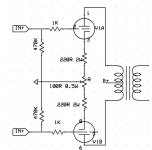Thanks Svein!
I just seen somewhere something like this.
I don't know how much could be the differences between unmatched EL84s.

Greets:
Tyimo
I just seen somewhere something like this.
I don't know how much could be the differences between unmatched EL84s.
Yes, I know.The cathode resistors must be bypassed though.
Greets:
Tyimo
Would a 0.5W multiturn trimpot be enough??
According to data sheet of EL84, the total cathode current of your circuit could be some 70 to 80 mA.
Then you can calculate the power dissipation of the 100 trimpot by well known formula P = IxI x R.
So with 80 mA the power over 100 ohms trimpot is 0,64 W. Obviously you need to have a more powerfull trimpot or smaller, for example 47 ohms would do well.
Then the power dissipation is only 0,3 W.
The push-pull circuit is not very sensitive to small unbalance between the anode currents. However, it will improve your amplifier if you can balance the currents. But then you should also adjust the driving voltages for both tubes. Since it is obvious that if the quiescent currents are not equal, then the "sensitivity" is not equal too.
But you need to have a distortion meter to achieve this "pink of perfection".
Adding the trimpot in series reduces reliability, as 'slider off track' is a common failure mode. If you want to trim (but in my opnion it is not really necessary) put a larger value trimpot in parallel with the cathode resistors. Trimpot failure then reduces to the output being as balanced as it would be with no trimpot, rather than complete failure.
- Status
- This old topic is closed. If you want to reopen this topic, contact a moderator using the "Report Post" button.
